
The increasing population poses a unique challenge to food availability. The national agriculture sector is expected to meet domestic food needs amid the threats of climate change.
This issue is also one of the targets in preparing for Golden Indonesia 2024. Therefore, there is a need for strategic cross-sector innovations to sustain Indonesia’s food production.
According to the Expert Staff for Connectivity in Service and Natural Resources Development, Coordinating Ministry of Economic Affairs, Dida Gardera, Indonesia needs to consider at least three crucial aspects as the 2023 Chair of ASEAN.
“These three key aspects are recovery and rebuilding, digital economy, and sustainability. Our economy has been resilient, with a 5% growth rate, which is extraordinary,” Gardera said.
“We are preparing to become an OECD member as part of a developed country. So, instead of being recipients, as usual, we must now be able to give more.”
One of the efforts to determine suitable strategies for agricultural issues is through research. Indonesia is known for its strong sense of kinship, reflected in its cooperative-based economic system. However, the development of cooperatives still needs to be improved.
“The anomaly in Indonesia lies in cooperatives. We are known for being friendly and communal, but cooperatives have never become large. Denmark, a country whose products now flood the world, initially started from cooperatives. The same goes for South Korea,” he added.
“Considering our strengths, we have enough potential to turn cooperatives into conglomerates. Hopefully, the agriculture sector can be the first to achieve that.”
Agricultural issues are also acknowledged by Professor Jamhari, a lecturer at the UGM Faculty of Agriculture, as a much more complex problem.
The demand in the agriculture sector is increasing because agricultural products are used for food and livestock feed, fuel, and fiber production. However, production is decreasing due to climate change. This is why the involvement of technology is crucial.
“When we look at it, farmers’ welfare is also squeezed. In the supply chain of agricultural products, the distribution system, the largest segment is in milling. So, farmers have not had substantial income from the beginning,” Professor Jamhari said.
“Furthermore, farmers face an oligopoly market. Small farmers are confronted with larger input markets, but their output is small.”
Also, the agriculture sector is still managed mainly at the micro level. Management remains at the individual farmer level despite many farmer groups and communities.
Previously, the dominance was held by small landholding farmers, but the situation is now worse.
Agricultural census data reveals that 48% of farmland is managed by tenant farmers or under lease systems. Therefore, the farmers do not own the available farmland, and whether the distribution system is equitable is unclear.
“Currently, there are no longer small landholding farmers but tenant and small farmers. We do not have rules prohibiting people from renting land, which differs from countries that have undergone land reform. We have small tenant farmers, which is even more challenging,” Professor Jamhari added.
In order to address these issues, there needs to be collaboration between sectors and parties, both in terms of policy and from the community.
Agricultural technology penetration needs to be increased to help farmers withstand the onslaught of climate change. This way, efforts towards food security can also be realized, and its sustainability can be maintained.
Author: Tasya

